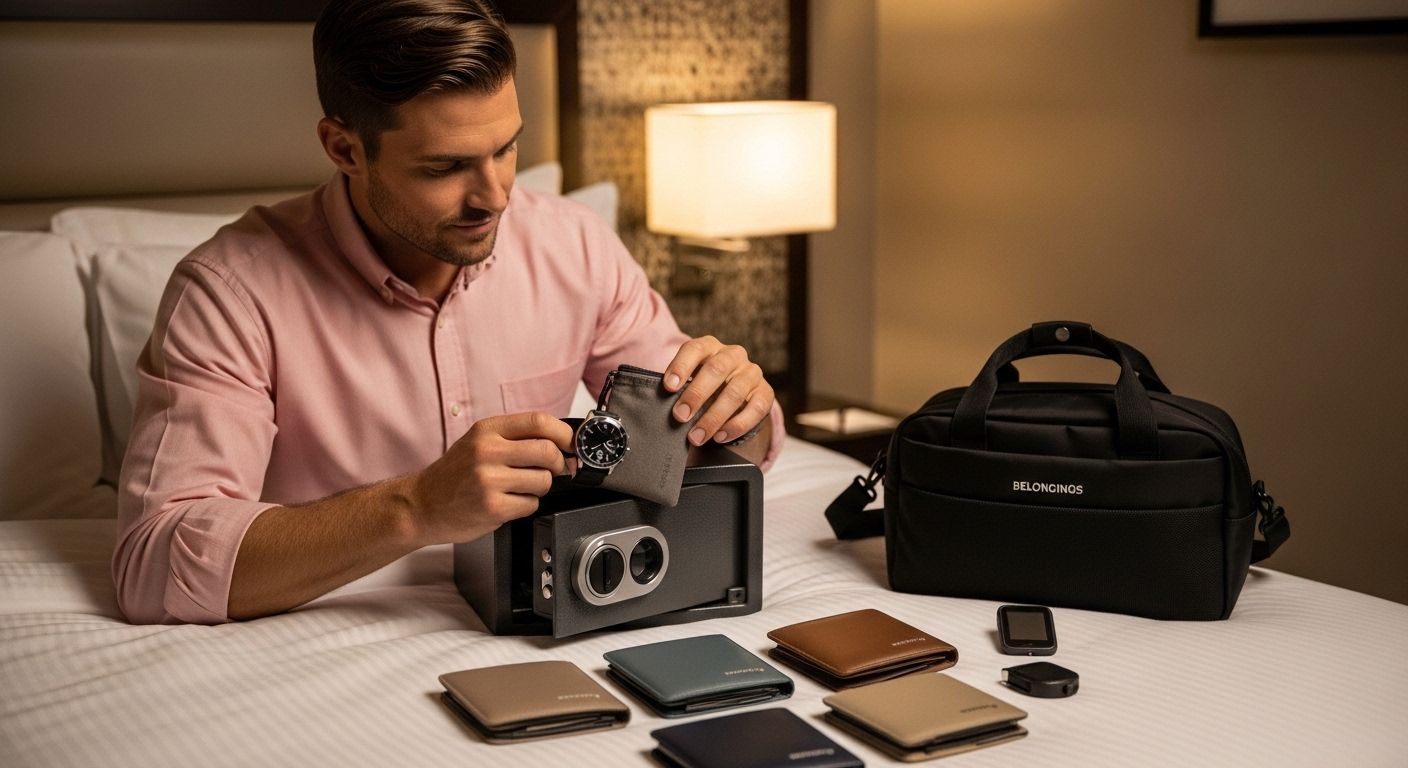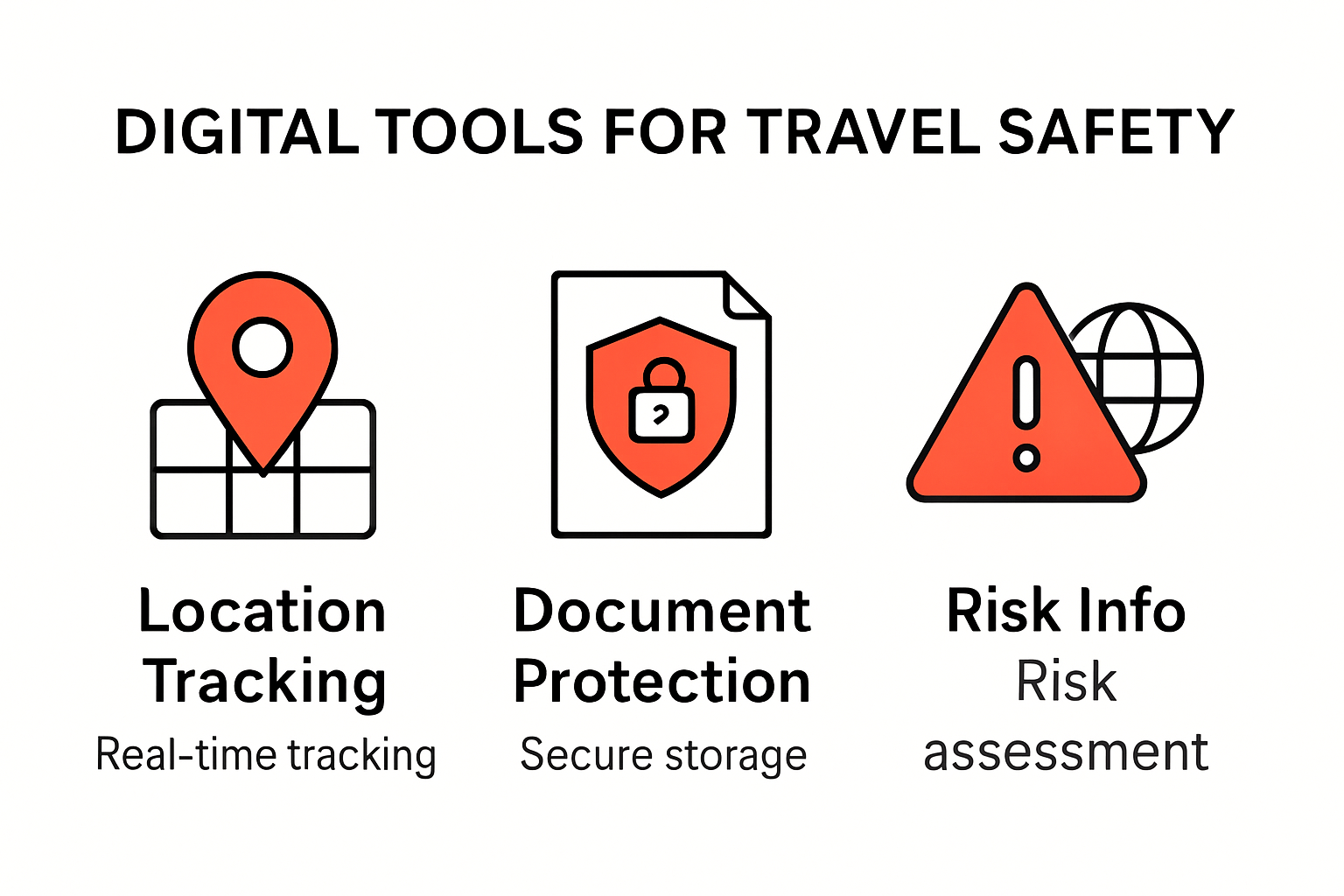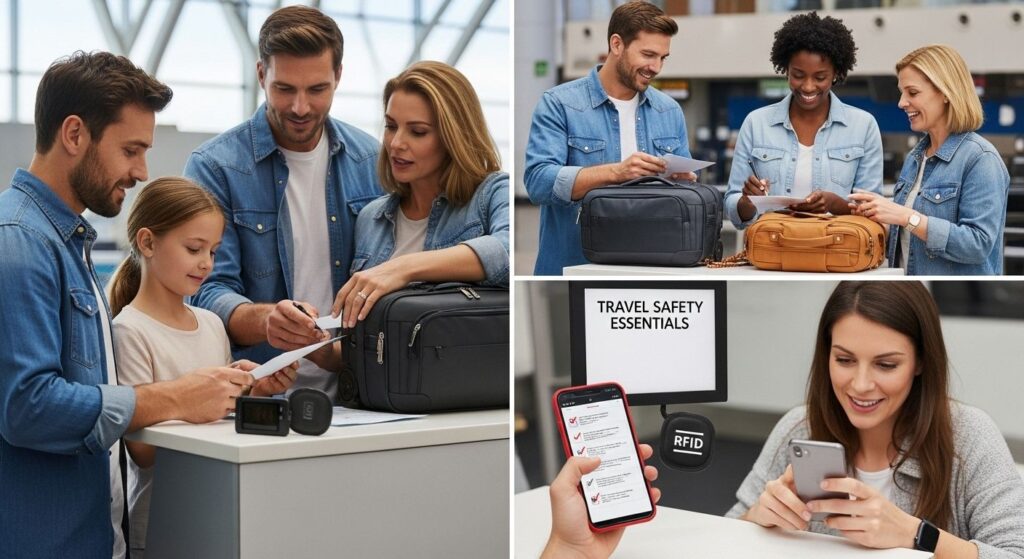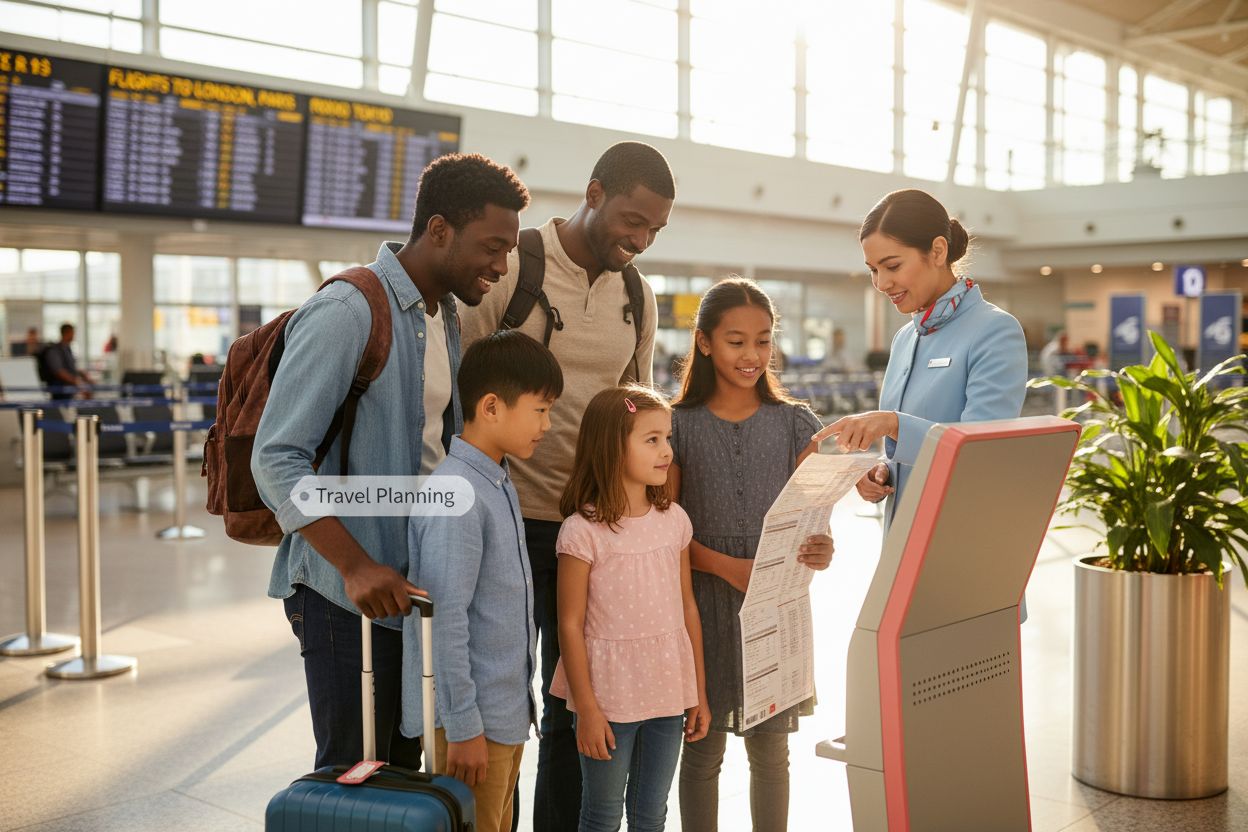Travel is supposed to be all adventure and discovery. Yet over 400,000 pickpocketing incidents happen worldwide every single day, turning vacations into headaches fast. Most travelers still believe a simple money belt is enough to keep them safe but the truth is, staying protected now means using smarter gear, backup plans, and tech nobody told you about.
Table of Contents
- Must-Have Travel Safety Essentials For Every Trip
- How To Secure Your Belongings On The Go
- Smart Tips For Family And Solo Traveler Safety
- Tech And Apps That Boost Your Travel Security
Quick Summary
| Takeaway | Explanation |
|---|---|
| Create and store backup documents | Make physical and digital copies of important documents like passports and insurance, stored securely in separate locations. |
| Invest in anti-theft gear | Utilize RFID-blocking wallets and portable travel safes to protect valuables from theft during travel. |
| Stay aware of your surroundings | Maintain vigilance by avoiding costly items on display and staying informed about local safety risks. |
| Use emergency communication apps | Download apps that enable real-time location sharing and emergency alerts to enhance safety while traveling. |
| Establish clear communication plans | For families and solo travelers, set up predetermined meeting points and share itineraries with trusted contacts for improved safety. |
Must-Have Travel Safety Essentials for Every Trip
Traveling opens up exciting opportunities for adventure, but staying safe requires strategic preparation and smart decision-making. Protecting yourself and your belongings isn’t about being paranoid – it’s about being proactive and prepared. Learn more about comprehensive travel planning to ensure a smooth and secure journey.
Personal Safety Equipment and Documentation
Your first line of defense starts with smart documentation and protective gear. The U.S. Department of State recommends travelers create multiple backup copies of critical documents. This means making physical and digital copies of your passport, driver’s license, travel insurance, and emergency contact information. Store digital copies securely in encrypted cloud storage and keep physical copies in separate locations from the originals.
Below is a summary table of key personal safety equipment and documentation essentials, outlining their main purposes for traveler protection.
| Item | Purpose |
|---|---|
| Personal Alarm | Attracts attention during potential threats |
| Portable Door Lock | Adds extra security to hotel or rental accommodation |
| RFID Blocking Wallet | Prevents electronic pickpocketing and data theft |
| Backup Document Copies | Provides access if originals are lost or stolen |
| Encrypted Cloud Storage | Secures digital backups of important documents |
Key safety equipment should include:
- Personal Alarm: A small, loud device that can attract immediate attention during potential threats
- Portable Door Lock: An additional security measure for hotel rooms or rental accommodations
- RFID Blocking Wallet: Prevents electronic pickpocketing of credit card information
Smart Technology and Communication Strategies
Modern travelers have powerful technological tools to enhance personal safety. According to Brown University’s study on traveler safety, understanding local communication networks is crucial. Before departing, download offline maps, translation apps, and ensure your smartphone has international calling capabilities or a local SIM card.
Consider installing safety apps that offer real-time location sharing with trusted contacts, emergency service connections, and local security alerts. Enable two-factor authentication on all important accounts and consider a temporary international mobile plan that provides reliable coverage in your destination.
Situational Awareness and Preventative Measures
Perhaps the most critical travel safety essential is developing keen situational awareness. This means staying alert to your surroundings, avoiding displaying expensive items, and understanding local cultural norms that might impact personal security. Research your destination’s specific safety considerations beforehand, understand potential risks, and develop basic emergency response strategies.
Key preventative practices include:
- Maintaining low-profile clothing and accessories
- Avoiding public discussions about travel plans or accommodation details
- Keeping valuable items in front pockets or secure, cross-body bags
- Staying in well-lit, populated areas during evening hours
Traveling safely isn’t about limiting your experiences – it’s about empowering yourself with knowledge and preparation. By implementing these travel safety essentials, you create a protective framework that allows you to explore confidently and enthusiastically.
How to Secure Your Belongings on the Go
Protecting your belongings during travel requires strategic planning and smart techniques that go beyond basic precautions. Every traveler needs a comprehensive approach to safeguarding personal items, whether navigating busy airports, exploring crowded tourist destinations, or moving between accommodations. Discover smart packing strategies to enhance your travel security.
Strategic Packing and Item Distribution
The Centers for Disease Control and Prevention recommends a critical strategy of distributing valuables across multiple locations. This means never keeping all cash, credit cards, and important documents in a single wallet or bag. Consider using a combination of secure storage methods: a money belt worn under clothing, a hidden neck wallet, and separate secure compartments in different bags.
Key distribution techniques include:
- Keeping a small amount of cash in an easily accessible wallet
- Storing backup credit cards in a hotel safe
- Keeping digital copies of important documents in encrypted cloud storage
- Carrying a dummy wallet with minimal cash to deter potential thieves
Technology and Anti-Theft Gear
Modern travelers have access to advanced anti-theft technologies that provide enhanced protection. The Transportation Security Administration emphasizes the importance of keeping essential electronics and valuable items within close reach. Invest in specialized travel gear designed to prevent theft and protect your belongings.
The following table summarizes recommended travel safety and anti-theft technologies mentioned in the article, including their core functions.
| Technology / Gear | Function |
|---|---|
| RFID-blocking wallet | Blocks electronic pickpocketing |
| Lockable zipper bag | Secures belongings in day bags |
| Portable travel safe | Stores valuables in hotel rooms |
| GPS tracking device | Helps locate lost or stolen items |
| Luggage lock | Prevents unauthorized access to luggage |
| Dummy wallet | Deters thieves with minimal cash/cards |
Recommended anti-theft technologies and gear:
- RFID-blocking wallets and passport holders: Prevent electronic pickpocketing and digital theft
- Lockable zipper bags: Provide an additional layer of security for day bags
- Portable travel safes: Compact lockable containers for securing items in hotel rooms
- GPS tracking devices: Small trackers that can help locate lost or stolen items
Situational Awareness and Prevention Techniques
Beyond physical security measures, developing strong situational awareness is crucial for protecting your belongings. This involves being constantly mindful of your surroundings and potential security risks. Pay attention to your environment, avoid displaying expensive items, and remain alert in crowded spaces like public transportation, tourist attractions, and busy markets.
Prevention strategies to minimize theft risk:
- Always keep bags and backpacks in front of you in crowded areas
- Use luggage locks when traveling
- Avoid setting bags down in public spaces
- Be cautious when using public Wi-Fi networks
- Stay informed about common local scams and theft techniques
Securing your belongings isn’t about creating unnecessary stress – it’s about creating a protective strategy that allows you to travel with confidence and peace of mind. By implementing these comprehensive approaches, you significantly reduce the risk of theft and loss, ensuring a more enjoyable and worry-free travel experience.

Smart Tips for Family and Solo Traveler Safety
Whether you’re traveling solo or with family, personal safety requires tailored strategies that address unique challenges and potential risks. Each travel scenario demands specific precautions and awareness techniques. Explore comprehensive travel planning resources to enhance your safety approach.
Communication and Emergency Preparedness
The U.S. Department of State emphasizes the critical importance of communication and emergency planning for all travelers. For families, this means establishing clear safety protocols and creating a unified communication strategy. Solo travelers should develop a robust personal communication plan that includes regular check-ins with trusted contacts.
Key communication and emergency preparedness strategies:
- Establish predetermined meeting points for family travel
- Share detailed itineraries with trusted contacts
- Create emergency contact cards for all family members
- Download offline maps and translation apps
- Memorize important local emergency service numbers
Health and Personal Security Considerations
According to the Centers for Disease Control and Prevention, health and personal security are interconnected aspects of travel safety. For families, this means preparing comprehensive health kits and understanding each member’s specific medical needs. Solo travelers must be equally vigilant about personal health and security preparedness.
Recommended health and security preparations:
- Travel Insurance: Comprehensive coverage for medical emergencies
- Medical Kit: Prescription medications, basic first aid supplies
- Vaccination Records: Updated immunization documentation
- Emergency Medical Information: Copies of medical history and allergies
- Local Healthcare Research: Understand medical facilities at your destination
Destination-Specific Safety Strategies
Every destination presents unique safety challenges that require adaptive strategies. The CDC’s travel safety guidelines highlight the importance of understanding local customs, legal frameworks, and potential risks specific to your destination.
Destination safety preparation techniques:
- Research local cultural norms and potential safety risks
- Understand local laws and potential legal restrictions
- Learn basic local language phrases for emergencies
- Register travel plans with government travel programs
- Develop situational awareness specific to local environments
Travel safety isn’t about creating fear – it’s about empowering yourself with knowledge and preparation. By implementing these comprehensive strategies, both family and solo travelers can create a protective framework that allows for confident, secure, and enjoyable travel experiences. Your preparedness becomes the foundation for memorable and worry-free adventures.
Tech and Apps That Boost Your Travel Security
Technology has revolutionized travel safety, providing travelers with powerful digital tools to enhance personal security and peace of mind. Modern smartphones and innovative apps offer comprehensive protection strategies that go far beyond traditional safety measures. Discover the latest travel planning technologies to maximize your travel safety.
Location Tracking and Emergency Communication Apps
The U.S. Department of State’s Traveler’s Checklist recommends leveraging technology for real-time safety monitoring. Advanced location tracking and emergency communication apps provide travelers with critical safety features that can be lifesaving in unexpected situations.
Top recommended safety communication technologies:
- Find My Friends: Real-time location sharing with trusted contacts
- Life360: Comprehensive family safety tracking platform
- bSafe: Personal safety app with emergency alert system
- Noonlight: Automatic emergency dispatching service
- What3Words: Precise global location identification system
Digital Security and Document Protection Apps
Protecting digital information has become as crucial as safeguarding physical belongings. Advanced apps now offer comprehensive digital security solutions that help travelers protect sensitive personal and financial information across multiple platforms and devices.
Critical digital security applications include:
- LastPass: Secure password management and encryption
- NordVPN: Virtual private network for secure internet connections
- Authy: Two-factor authentication and account protection
- Signal: Encrypted messaging and communication platform
- Google Drive: Secure cloud storage for important documents
Travel Risk Assessment and Information Apps
Modern travelers can access real-time information about potential risks, local conditions, and emergency resources through sophisticated mobile applications. These apps provide comprehensive insights that help travelers make informed decisions and stay prepared for various scenarios.
Essential travel risk and information apps:

- TravelSmart: Comprehensive travel risk assessment platform
- Smart Traveler: Government travel advisory and emergency notification system
- GeoSure: Neighborhood-level safety scoring and risk assessment
- TripWhistle Global SOS: International emergency service directory
- Sitata: Real-time travel safety and health alert system
Technology has transformed travel safety from reactive protection to proactive prevention. By strategically utilizing these innovative apps and digital tools, travelers can create a comprehensive safety network that provides real-time monitoring, instant communication, and immediate access to critical resources. Your smartphone becomes more than a communication device – it becomes a powerful personal safety companion that helps you navigate the world with confidence and security.
Frequently Asked Questions
What are the essential travel safety items I should carry?
It’s important to carry personal safety items such as a personal alarm, portable door lock, and RFID blocking wallet. Additionally, having backup document copies and encrypted cloud storage is crucial for protecting important information.
How can I enhance my situational awareness while traveling?
To enhance situational awareness, stay alert to your surroundings, avoid displaying expensive items, and remain informed about cultural norms and local safety risks. Always keep valuable items in secure, close-to-body bags.
What technology can I use to secure my belongings during travel?
Invest in anti-theft gear such as RFID-blocking wallets, lockable bags, and portable travel safes. GPS tracking devices can also help recover lost or stolen items, providing an additional layer of security.
How can I establish a communication plan for family members while traveling?
Establish predetermined meeting points for family members, share detailed itineraries with trusted contacts, and create emergency contact cards. Utilizing offline maps and translation apps can help maintain effective communication in case of emergencies.
Move From Stressful Worry to Effortless Travel Security With Yopki
You have just learned how essential planning, smart gear, and advanced apps are for travel safety. But when the pressure is on to juggle backup documents, organize routes, and stay connected to your loved ones, even the best traveler can feel overwhelmed. Imagine if you could instantly create a secure travel plan, organize your itinerary with a visual map, and keep all your key bookings and personal details protected in one place.

Experience what it is like to plan smarter and travel safer with Yopki. From centralizing your flight details and essential documents to visually organizing your days for minimal stress, our web app gives you the power to prepare and protect every step of your adventure. Ready to leave stress behind and enjoy seamless security? Explore our instant itinerary builder now and see how Yopki takes care of every detail so you can focus on making memories.



